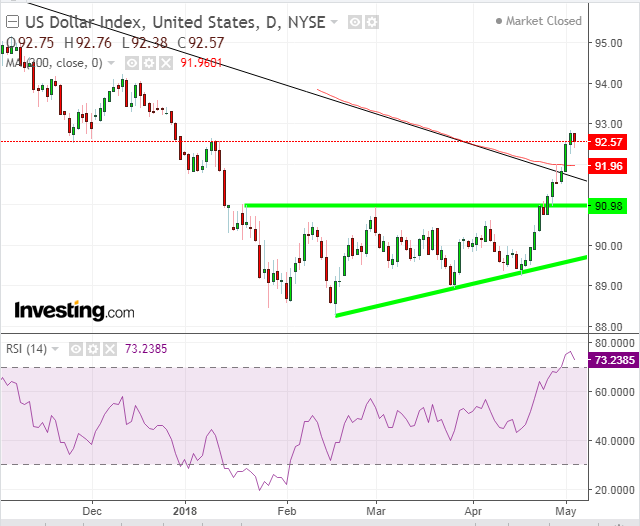The dollar is falling, after its longest and strongest rally since September, from a low of 89.23 to a high of 92.83, or a 4 percent rise, within three weeks.
Most opinions cite a fundamental cause for this fall, namely the faster pace of Fed tightening. However, there may also be another technical explanation. COT data reveals that traders have been shorting the dollar at near-record levels. The reserve currency's rebound blew up in their faces, forcing them to cover near-record-level shorts.
After rising for ten days out of 11, it makes perfect sense there would be profit taking. The RSI is falling (as the currency is still in overbought territory) from 76, the highest read since the US election back in November 2016. The greenback turned overbought after rising 600 points, or 6,25 percent, in conjunction with the Trump Trade.
There are currently two schools of thought regarding the dollar's project direction. Those who focus on the overbought RSI read expect a correction, while those focusing on it surpassing the 200 DMA on Monday expect it to continue rallying. The facts seem to support the latter group, as even after the greenback reached the extreme RSI overbought condition of November 2016, it resolutely climbed another 200 points or 2 percent.
While the 200 DMA penetration has been less than even 1 percent, thereby inviting a bull-trap, it has crossed above its downtrend line for the first time, since December 2016 when President Donald Trump decimated the USD after he told the Wall Street Journal that the strong dollar "is killing us."
Also, the weekly RSI penetrated a resistance in October, establishing an uptrend for momentum.
Could Saudi Arabia Be Trying To Weaken The USD?
So what exactly could be causing the dollar to fall? It's well-established that a strong dollar is weighing on the price of oil, in addition to other commodities. We have pointed out previously that Saudi Arabia will do whatever it takes to support oil prices, ahead of its Aramco IPO. While the following theory is compelling, it's important to point out that it's mostly speculation, as we have no evidence to support it.
Saudi Arabia has liquidated much of its foreign assets, to cover a budget deficit caused by low oil prices, which shrank by $40 billion in the last year. However, in stark contrast, Saudi holdings of Treasuries reached a one-year high of $114.4 billion in March, from a low of $89.5 billion last September. Saudi Arabia is the 12th biggest foreign investor in US Treasuries.
There has always been the concern that China would attack the US by dumping its bonds. That fear is even bigger now, as investors worry China may hold US investments as leverage during trade (or perhaps other) negotiations. In this case however, that fear has been continuously allayed by the claim that China needs Treasuries for financial stability. 'Killing' the Treasury market would be akin to the Chinese shooting themselves in the foot.
Saudi Arabia's situation, however is very different than that of China. First, their $114.4 billion position is a laughable tenth of China's $1.16 trillion holdings. Second, Saudi Arabia is not relying on the US for financial stability. On the contrary, they have been divesting from other countries and their single focus is to increase the value of their primary commodity and marketable product as much as possible.
So we have to wonder, is it possible that Saudi Arabia is preparing to weaken the dollar by liquidating their US government bond holdings, boosting the price of oil before their IPO? We don't have an answer, of course, but it's interesting to speculate.


